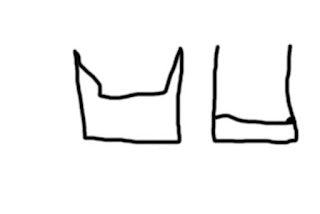
When Testing for Proper Wick Size Should You Always Test the Same Way? Trapped Heat Makes a Difference.
Share
Trapped heat is the excess heat that builds up in a container. As the depth increases so does the trapped heat. A 2" deep container will not have as much trapped heat (heat build up) as a 3" container of the same diameter. This is important to know because trapped heat will greatly affect how your candle burns and the wicks that are needed.
What this means is that you will need to have different criteria when testing different depths of candles. Most of your testing data will be the same but the expectation of when a full melt pool should be achieved will change. For instance, with a candle that is about 2" deep or less we would want to achieve a full melt pool on the first burn. Unlike a 3" deep candle which should achieve a full melt pool at about 1/3 - 1/2 of the way down the candle. Because if we achieved a full melt pool on the first burn chances are very good that we would get a flame thrower by the time the wick reached the bottom of the candle with a deeper candle. As a candle burns down it burns out. The deeper the candle the more the trapped heat melts the wax on the sides of the candle and the hotter it can get.
Another factor involving trapped heat is the composition of the container. Metal conducts heat more than glass or ceramic. Both glass and ceramic act as insulators which cause more trapped heat as metal will cause more loss of heat from a container. In other words you may require a slightly bigger wick when working with a metal vs glass or ceramic container of the same size.
Please excuse my very crude drawing of two 3" deep candles (3" diameter as well). I am trying to demonstrate that at about 1/3-1/2 way down the trapped heat of the container will help melt the sides of the candle closer to the top. And then as the candle burns down the trapped heat will result in full melt pools (after about 3 hours of burn time for a 3" diameter candle)
On the other hand, if the candle is only 2" deep (3" diameter) the melt pool would need to be full (all the way across) after about 3 hours. Don't forget the rule of candle burning--1 inch melted in diameter for every hour of burn time.
One more little note. A candle burns faster at its center than it does its edges. This is simply because it is hotter at the center and cooler at the edges so the inch per hour is an average for your candle. If you have a 3" diameter candle the flame may melt the first 2" in the first hour but may take 2 hours to do the third inch. And that is ok because it is an average of one inch per hour.
I hope that this helps take some of the mystery out of how to test burn candles! If there is anything else that we can help you with please contact customer@candlecocoon.com
If you need candle making supplies please visit us at Candle Cocoon
What this means is that you will need to have different criteria when testing different depths of candles. Most of your testing data will be the same but the expectation of when a full melt pool should be achieved will change. For instance, with a candle that is about 2" deep or less we would want to achieve a full melt pool on the first burn. Unlike a 3" deep candle which should achieve a full melt pool at about 1/3 - 1/2 of the way down the candle. Because if we achieved a full melt pool on the first burn chances are very good that we would get a flame thrower by the time the wick reached the bottom of the candle with a deeper candle. As a candle burns down it burns out. The deeper the candle the more the trapped heat melts the wax on the sides of the candle and the hotter it can get.
Another factor involving trapped heat is the composition of the container. Metal conducts heat more than glass or ceramic. Both glass and ceramic act as insulators which cause more trapped heat as metal will cause more loss of heat from a container. In other words you may require a slightly bigger wick when working with a metal vs glass or ceramic container of the same size.
Please excuse my very crude drawing of two 3" deep candles (3" diameter as well). I am trying to demonstrate that at about 1/3-1/2 way down the trapped heat of the container will help melt the sides of the candle closer to the top. And then as the candle burns down the trapped heat will result in full melt pools (after about 3 hours of burn time for a 3" diameter candle)
On the other hand, if the candle is only 2" deep (3" diameter) the melt pool would need to be full (all the way across) after about 3 hours. Don't forget the rule of candle burning--1 inch melted in diameter for every hour of burn time.
One more little note. A candle burns faster at its center than it does its edges. This is simply because it is hotter at the center and cooler at the edges so the inch per hour is an average for your candle. If you have a 3" diameter candle the flame may melt the first 2" in the first hour but may take 2 hours to do the third inch. And that is ok because it is an average of one inch per hour.
I hope that this helps take some of the mystery out of how to test burn candles! If there is anything else that we can help you with please contact customer@candlecocoon.com
If you need candle making supplies please visit us at Candle Cocoon

